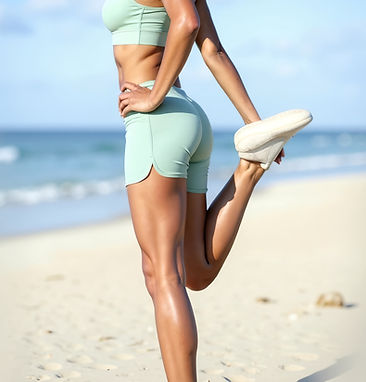
Stretching
Exercises.
Enhance your flexibility, performance and wellness.

All about stretching and mobility.
Sign up for my newsletter.
FAQ
Stretching focuses on increasing the length of a muscle, aiming primarily for flexibility. Mobility is broader; it refers to your ability to move a joint actively through its full range of motion with control. Mobility work often includes stretching but also incorporates strength, stability, and motor control exercises. Think of flexibility as passive range, and mobility as active, usable range.
Regular stretching offers numerous benefits, including improving flexibility, increasing range of motion, potentially reducing the risk of injury, alleviating muscle soreness, improving posture, and promoting relaxation and well-being. It helps maintain musculoskeletal health, especially important when counteracting sedentary work or engaging in demanding physical activity.
Mobility work helps improve joint health, enhances movement quality and efficiency, increases active range of motion, reduces the risk of injury by preparing joints for load, improves posture, and can alleviate stiffness or pain associated with restricted movement. It's crucial for functional fitness and athletic performance in activities like running, cycling, CrossFit, etc.
It depends on the type of stretching. Dynamic stretching (active movements that take your body through ranges of motion) is recommended before workouts as part of a warm-up. Static stretching (holding a stretch for a period) is generally best performed after a workout when muscles are warm, or as a separate flexibility session.
While no activity can guarantee injury prevention, improving mobility and flexibility can contribute. Good mobility ensures joints move correctly, reducing compensatory movements that can lead to strain. Appropriate warm-ups with dynamic stretching prepare tissues for activity, and post-workout stretching aids recovery. They are important components of a comprehensive injury prevention strategy.
Gentle stretching and light mobility work may help temporarily alleviate the discomfort of Delayed Onset Muscle Soreness (DOMS). While it might not drastically speed up the underlying muscle repair process, it can increase blood flow and reduce the sensation of stiffness, improving well-being post-exercise.
Yes, targeted stretching and mobility exercises can help improve posture, especially if you have imbalances caused by prolonged sitting or repetitive movements (common in office jobs). Stretching tight muscles (like chest and hip flexors) and strengthening weak muscles (like upper back and glutes) work together to promote better alignment.
Stretching should create a sensation of mild tension, not sharp or intense pain. If you feel pain, ease off the stretch immediately. Pain can indicate you're pushing too far, stretching incorrectly, or have an underlying injury. Always listen to your body. If pain persists, consult a healthcare professional.
In many cases, yes. Tight hamstrings, hip flexors, and glutes can contribute to lower back pain. Gentle stretching and mobility work for these areas, along with core strengthening, can often provide relief. However, if you have persistent or severe back pain, always consult a doctor or physical therapist first.
Foam rolling is a form of self-myofascial release (SMR). It's not stretching in the traditional sense but complements both stretching and mobility work. It can help release muscle tightness, improve tissue quality, increase blood flow, and enhance range of motion, making subsequent stretching potentially more effective. It's often used during warm-ups or cool-downs.
Disclaimer: The information provided in this FAQ is for general knowledge and informational purposes only, and does not constitute medical advice. Always consult with a qualified healthcare professional before beginning any new fitness or stretching program, especially if you have pre-existing health conditions or injuries. Listen to your body and stop if you feel pain.





